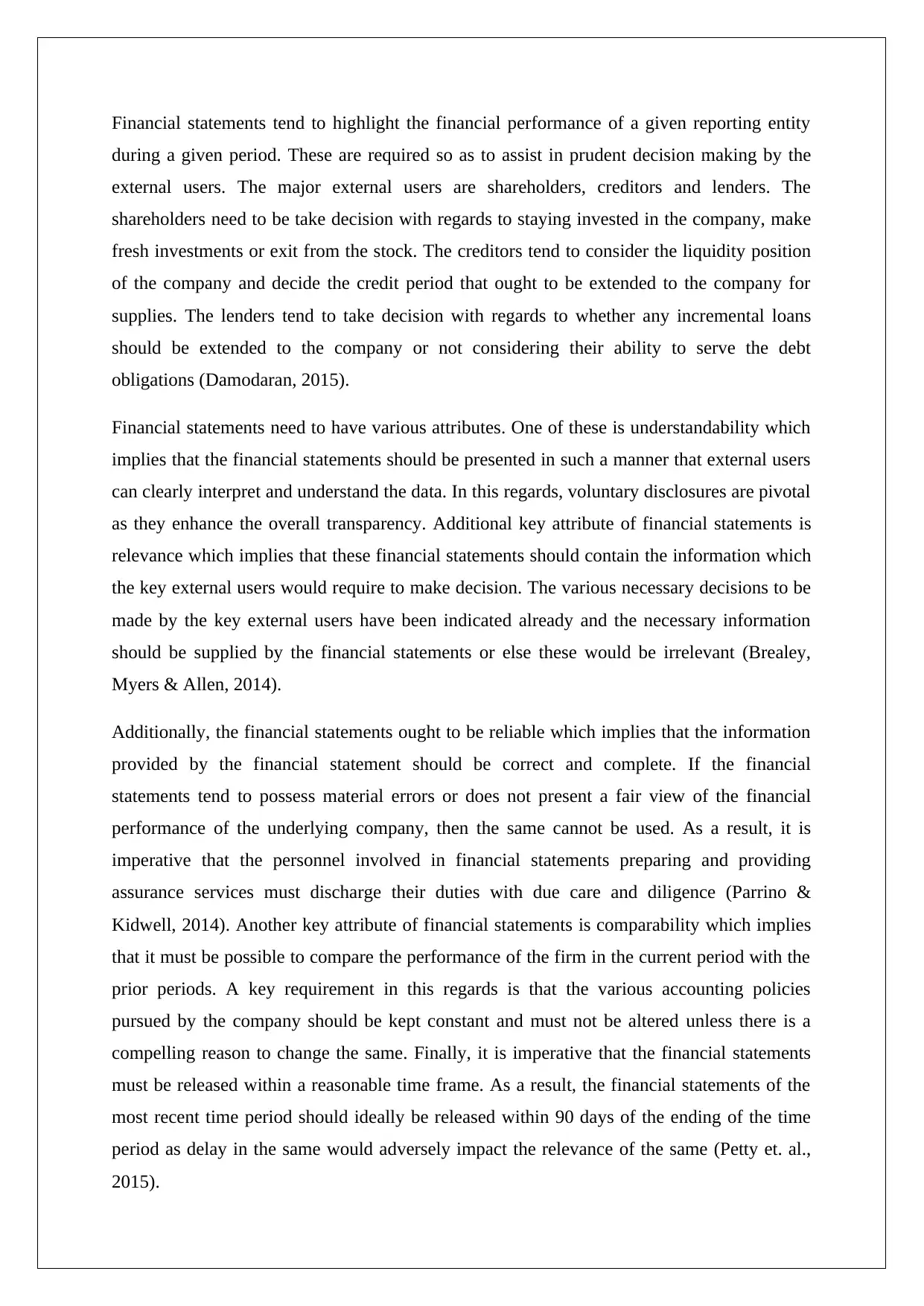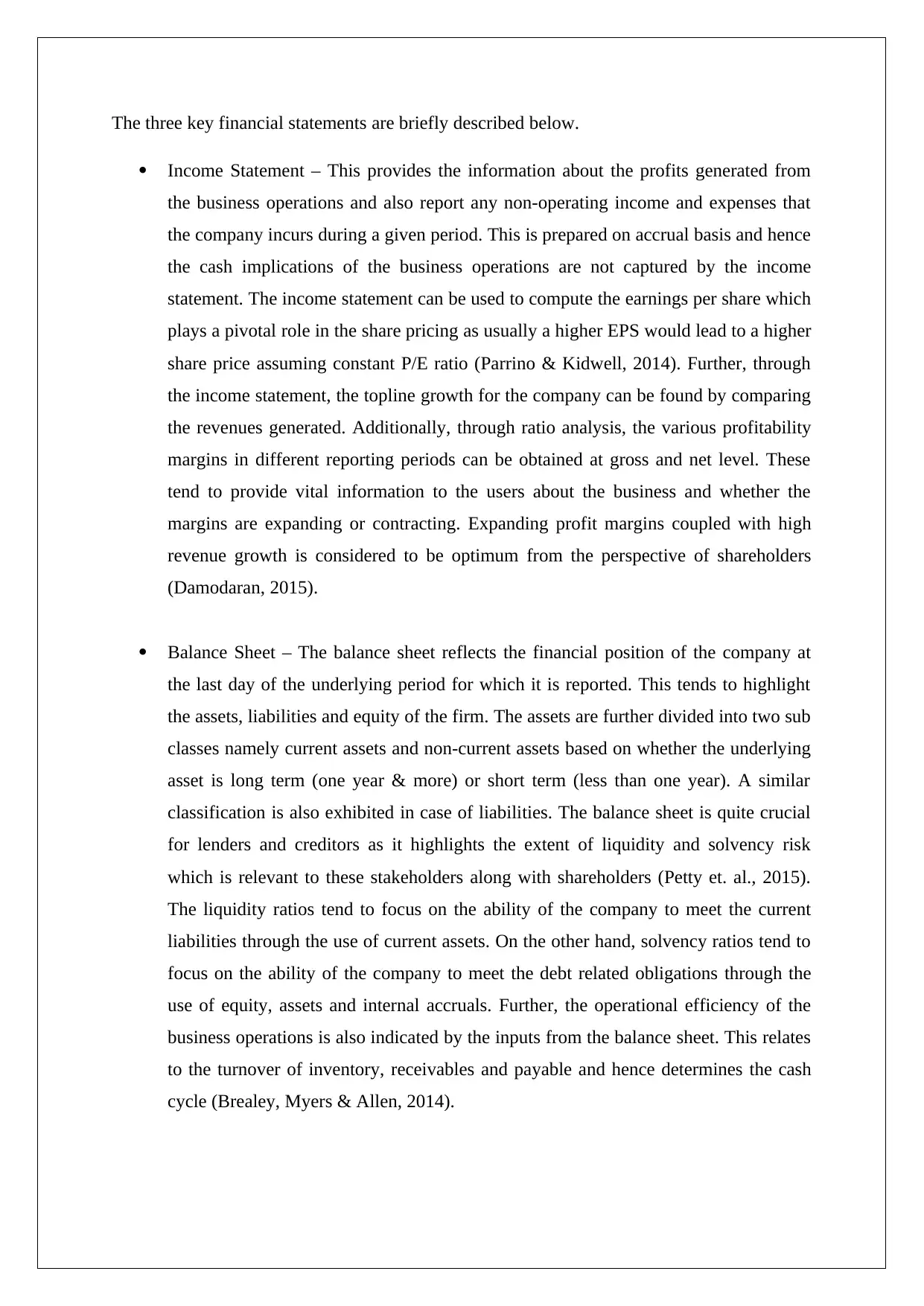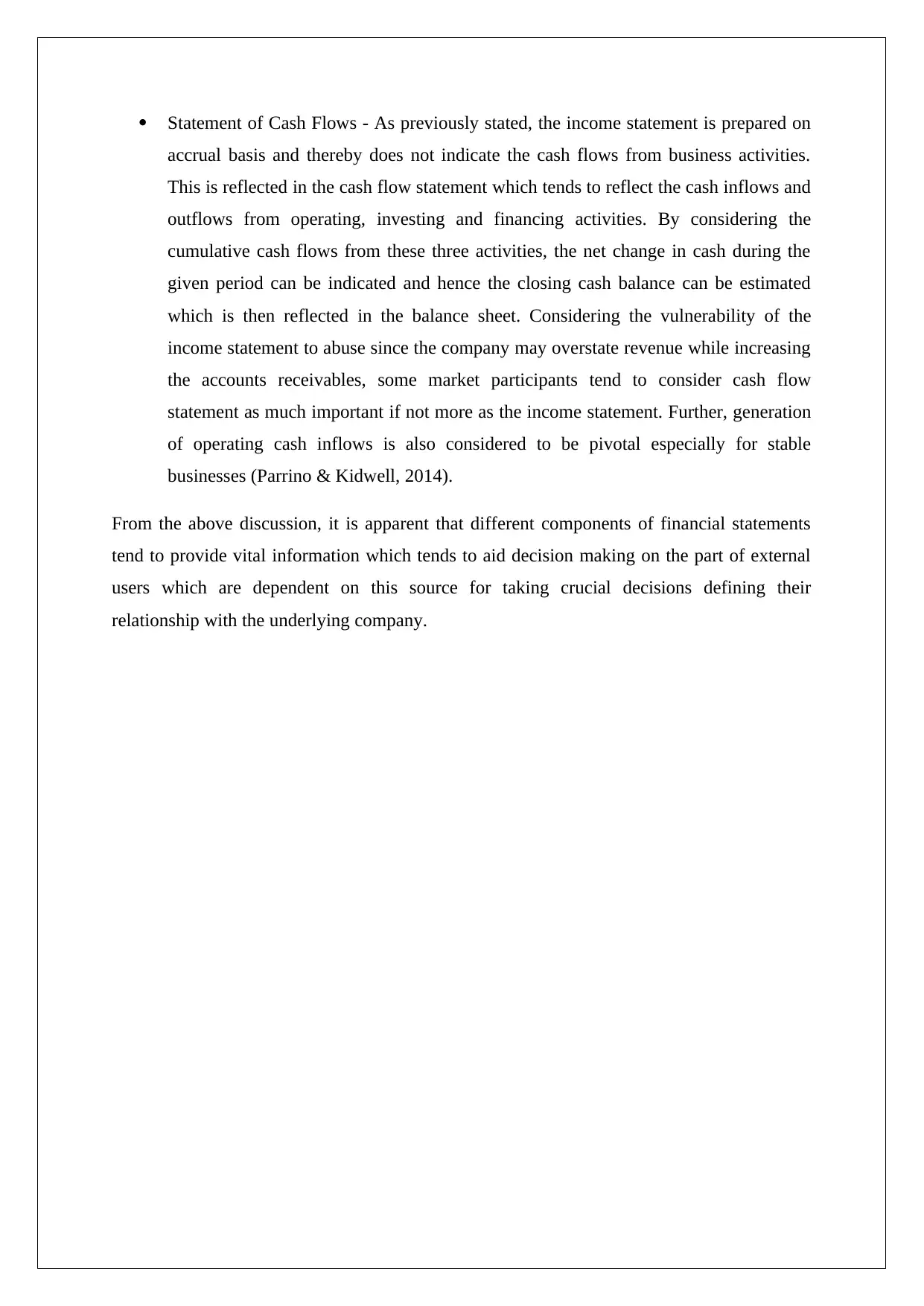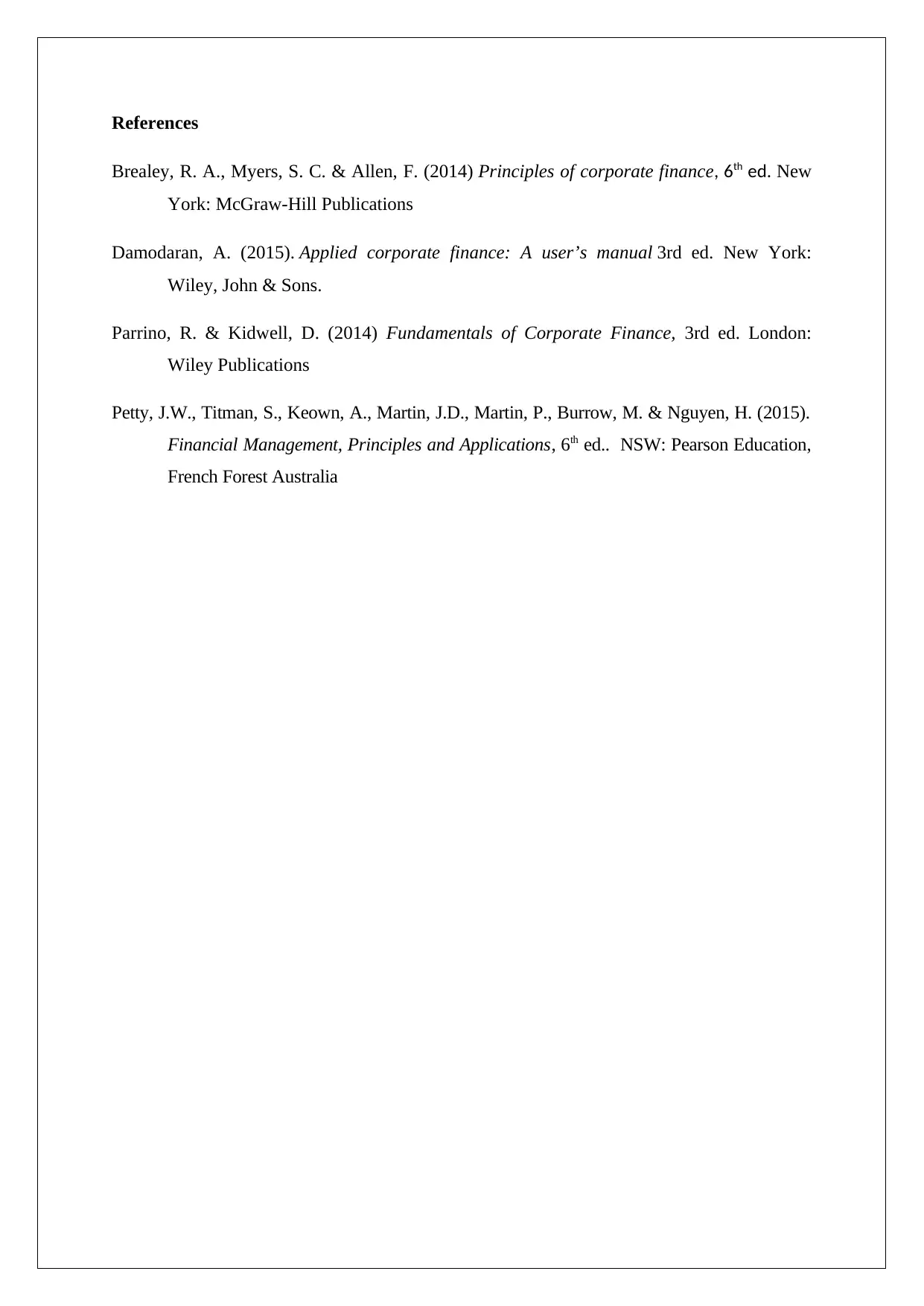Financial Statements: Attributes, Components, and Decision Making
VerifiedAdded on 2023/04/20
|5
|1271
|197
Essay
AI Summary
This essay provides a detailed analysis of financial statements, emphasizing their key attributes such as understandability, relevance, reliability, and comparability. It discusses the importance of financial statements in aiding decision-making for external users like shareholders, creditors, and lenders. The essay also examines the three primary financial statements: the income statement, balance sheet, and statement of cash flows, highlighting their individual roles in presenting a company's financial performance and position. The income statement reveals profitability, the balance sheet reflects assets, liabilities, and equity, and the cash flow statement indicates cash inflows and outflows from operating, investing, and financing activities. The document concludes by underscoring the critical role of these statements in providing vital information for stakeholders to make informed decisions about their relationship with the company.

FINANCIAL STATEMENTS
STUDENT ID:
[Pick the date]
STUDENT ID:
[Pick the date]
Paraphrase This Document
Need a fresh take? Get an instant paraphrase of this document with our AI Paraphraser

Financial statements tend to highlight the financial performance of a given reporting entity
during a given period. These are required so as to assist in prudent decision making by the
external users. The major external users are shareholders, creditors and lenders. The
shareholders need to be take decision with regards to staying invested in the company, make
fresh investments or exit from the stock. The creditors tend to consider the liquidity position
of the company and decide the credit period that ought to be extended to the company for
supplies. The lenders tend to take decision with regards to whether any incremental loans
should be extended to the company or not considering their ability to serve the debt
obligations (Damodaran, 2015).
Financial statements need to have various attributes. One of these is understandability which
implies that the financial statements should be presented in such a manner that external users
can clearly interpret and understand the data. In this regards, voluntary disclosures are pivotal
as they enhance the overall transparency. Additional key attribute of financial statements is
relevance which implies that these financial statements should contain the information which
the key external users would require to make decision. The various necessary decisions to be
made by the key external users have been indicated already and the necessary information
should be supplied by the financial statements or else these would be irrelevant (Brealey,
Myers & Allen, 2014).
Additionally, the financial statements ought to be reliable which implies that the information
provided by the financial statement should be correct and complete. If the financial
statements tend to possess material errors or does not present a fair view of the financial
performance of the underlying company, then the same cannot be used. As a result, it is
imperative that the personnel involved in financial statements preparing and providing
assurance services must discharge their duties with due care and diligence (Parrino &
Kidwell, 2014). Another key attribute of financial statements is comparability which implies
that it must be possible to compare the performance of the firm in the current period with the
prior periods. A key requirement in this regards is that the various accounting policies
pursued by the company should be kept constant and must not be altered unless there is a
compelling reason to change the same. Finally, it is imperative that the financial statements
must be released within a reasonable time frame. As a result, the financial statements of the
most recent time period should ideally be released within 90 days of the ending of the time
period as delay in the same would adversely impact the relevance of the same (Petty et. al.,
2015).
during a given period. These are required so as to assist in prudent decision making by the
external users. The major external users are shareholders, creditors and lenders. The
shareholders need to be take decision with regards to staying invested in the company, make
fresh investments or exit from the stock. The creditors tend to consider the liquidity position
of the company and decide the credit period that ought to be extended to the company for
supplies. The lenders tend to take decision with regards to whether any incremental loans
should be extended to the company or not considering their ability to serve the debt
obligations (Damodaran, 2015).
Financial statements need to have various attributes. One of these is understandability which
implies that the financial statements should be presented in such a manner that external users
can clearly interpret and understand the data. In this regards, voluntary disclosures are pivotal
as they enhance the overall transparency. Additional key attribute of financial statements is
relevance which implies that these financial statements should contain the information which
the key external users would require to make decision. The various necessary decisions to be
made by the key external users have been indicated already and the necessary information
should be supplied by the financial statements or else these would be irrelevant (Brealey,
Myers & Allen, 2014).
Additionally, the financial statements ought to be reliable which implies that the information
provided by the financial statement should be correct and complete. If the financial
statements tend to possess material errors or does not present a fair view of the financial
performance of the underlying company, then the same cannot be used. As a result, it is
imperative that the personnel involved in financial statements preparing and providing
assurance services must discharge their duties with due care and diligence (Parrino &
Kidwell, 2014). Another key attribute of financial statements is comparability which implies
that it must be possible to compare the performance of the firm in the current period with the
prior periods. A key requirement in this regards is that the various accounting policies
pursued by the company should be kept constant and must not be altered unless there is a
compelling reason to change the same. Finally, it is imperative that the financial statements
must be released within a reasonable time frame. As a result, the financial statements of the
most recent time period should ideally be released within 90 days of the ending of the time
period as delay in the same would adversely impact the relevance of the same (Petty et. al.,
2015).

The three key financial statements are briefly described below.
Income Statement – This provides the information about the profits generated from
the business operations and also report any non-operating income and expenses that
the company incurs during a given period. This is prepared on accrual basis and hence
the cash implications of the business operations are not captured by the income
statement. The income statement can be used to compute the earnings per share which
plays a pivotal role in the share pricing as usually a higher EPS would lead to a higher
share price assuming constant P/E ratio (Parrino & Kidwell, 2014). Further, through
the income statement, the topline growth for the company can be found by comparing
the revenues generated. Additionally, through ratio analysis, the various profitability
margins in different reporting periods can be obtained at gross and net level. These
tend to provide vital information to the users about the business and whether the
margins are expanding or contracting. Expanding profit margins coupled with high
revenue growth is considered to be optimum from the perspective of shareholders
(Damodaran, 2015).
Balance Sheet – The balance sheet reflects the financial position of the company at
the last day of the underlying period for which it is reported. This tends to highlight
the assets, liabilities and equity of the firm. The assets are further divided into two sub
classes namely current assets and non-current assets based on whether the underlying
asset is long term (one year & more) or short term (less than one year). A similar
classification is also exhibited in case of liabilities. The balance sheet is quite crucial
for lenders and creditors as it highlights the extent of liquidity and solvency risk
which is relevant to these stakeholders along with shareholders (Petty et. al., 2015).
The liquidity ratios tend to focus on the ability of the company to meet the current
liabilities through the use of current assets. On the other hand, solvency ratios tend to
focus on the ability of the company to meet the debt related obligations through the
use of equity, assets and internal accruals. Further, the operational efficiency of the
business operations is also indicated by the inputs from the balance sheet. This relates
to the turnover of inventory, receivables and payable and hence determines the cash
cycle (Brealey, Myers & Allen, 2014).
Income Statement – This provides the information about the profits generated from
the business operations and also report any non-operating income and expenses that
the company incurs during a given period. This is prepared on accrual basis and hence
the cash implications of the business operations are not captured by the income
statement. The income statement can be used to compute the earnings per share which
plays a pivotal role in the share pricing as usually a higher EPS would lead to a higher
share price assuming constant P/E ratio (Parrino & Kidwell, 2014). Further, through
the income statement, the topline growth for the company can be found by comparing
the revenues generated. Additionally, through ratio analysis, the various profitability
margins in different reporting periods can be obtained at gross and net level. These
tend to provide vital information to the users about the business and whether the
margins are expanding or contracting. Expanding profit margins coupled with high
revenue growth is considered to be optimum from the perspective of shareholders
(Damodaran, 2015).
Balance Sheet – The balance sheet reflects the financial position of the company at
the last day of the underlying period for which it is reported. This tends to highlight
the assets, liabilities and equity of the firm. The assets are further divided into two sub
classes namely current assets and non-current assets based on whether the underlying
asset is long term (one year & more) or short term (less than one year). A similar
classification is also exhibited in case of liabilities. The balance sheet is quite crucial
for lenders and creditors as it highlights the extent of liquidity and solvency risk
which is relevant to these stakeholders along with shareholders (Petty et. al., 2015).
The liquidity ratios tend to focus on the ability of the company to meet the current
liabilities through the use of current assets. On the other hand, solvency ratios tend to
focus on the ability of the company to meet the debt related obligations through the
use of equity, assets and internal accruals. Further, the operational efficiency of the
business operations is also indicated by the inputs from the balance sheet. This relates
to the turnover of inventory, receivables and payable and hence determines the cash
cycle (Brealey, Myers & Allen, 2014).
⊘ This is a preview!⊘
Do you want full access?
Subscribe today to unlock all pages.

Trusted by 1+ million students worldwide

Statement of Cash Flows - As previously stated, the income statement is prepared on
accrual basis and thereby does not indicate the cash flows from business activities.
This is reflected in the cash flow statement which tends to reflect the cash inflows and
outflows from operating, investing and financing activities. By considering the
cumulative cash flows from these three activities, the net change in cash during the
given period can be indicated and hence the closing cash balance can be estimated
which is then reflected in the balance sheet. Considering the vulnerability of the
income statement to abuse since the company may overstate revenue while increasing
the accounts receivables, some market participants tend to consider cash flow
statement as much important if not more as the income statement. Further, generation
of operating cash inflows is also considered to be pivotal especially for stable
businesses (Parrino & Kidwell, 2014).
From the above discussion, it is apparent that different components of financial statements
tend to provide vital information which tends to aid decision making on the part of external
users which are dependent on this source for taking crucial decisions defining their
relationship with the underlying company.
accrual basis and thereby does not indicate the cash flows from business activities.
This is reflected in the cash flow statement which tends to reflect the cash inflows and
outflows from operating, investing and financing activities. By considering the
cumulative cash flows from these three activities, the net change in cash during the
given period can be indicated and hence the closing cash balance can be estimated
which is then reflected in the balance sheet. Considering the vulnerability of the
income statement to abuse since the company may overstate revenue while increasing
the accounts receivables, some market participants tend to consider cash flow
statement as much important if not more as the income statement. Further, generation
of operating cash inflows is also considered to be pivotal especially for stable
businesses (Parrino & Kidwell, 2014).
From the above discussion, it is apparent that different components of financial statements
tend to provide vital information which tends to aid decision making on the part of external
users which are dependent on this source for taking crucial decisions defining their
relationship with the underlying company.
Paraphrase This Document
Need a fresh take? Get an instant paraphrase of this document with our AI Paraphraser

References
Brealey, R. A., Myers, S. C. & Allen, F. (2014) Principles of corporate finance, 6th ed. New
York: McGraw-Hill Publications
Damodaran, A. (2015). Applied corporate finance: A user’s manual 3rd ed. New York:
Wiley, John & Sons.
Parrino, R. & Kidwell, D. (2014) Fundamentals of Corporate Finance, 3rd ed. London:
Wiley Publications
Petty, J.W., Titman, S., Keown, A., Martin, J.D., Martin, P., Burrow, M. & Nguyen, H. (2015).
Financial Management, Principles and Applications, 6th ed.. NSW: Pearson Education,
French Forest Australia
Brealey, R. A., Myers, S. C. & Allen, F. (2014) Principles of corporate finance, 6th ed. New
York: McGraw-Hill Publications
Damodaran, A. (2015). Applied corporate finance: A user’s manual 3rd ed. New York:
Wiley, John & Sons.
Parrino, R. & Kidwell, D. (2014) Fundamentals of Corporate Finance, 3rd ed. London:
Wiley Publications
Petty, J.W., Titman, S., Keown, A., Martin, J.D., Martin, P., Burrow, M. & Nguyen, H. (2015).
Financial Management, Principles and Applications, 6th ed.. NSW: Pearson Education,
French Forest Australia
1 out of 5
Related Documents
Your All-in-One AI-Powered Toolkit for Academic Success.
+13062052269
info@desklib.com
Available 24*7 on WhatsApp / Email
![[object Object]](/_next/static/media/star-bottom.7253800d.svg)
Unlock your academic potential
Copyright © 2020–2025 A2Z Services. All Rights Reserved. Developed and managed by ZUCOL.





